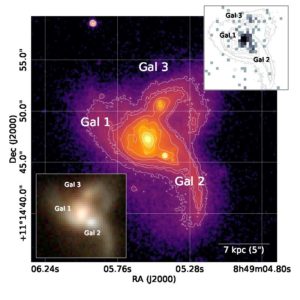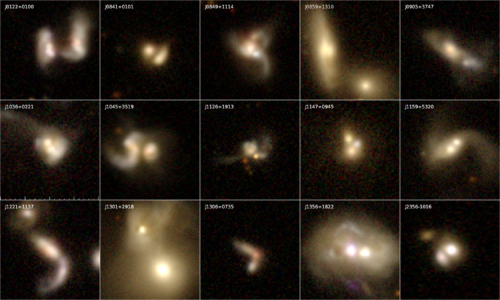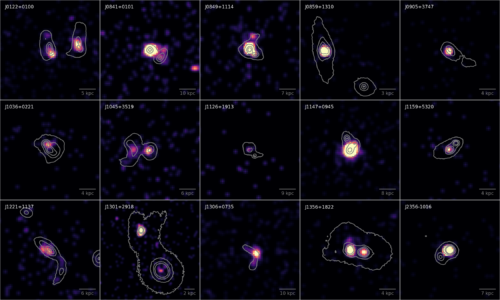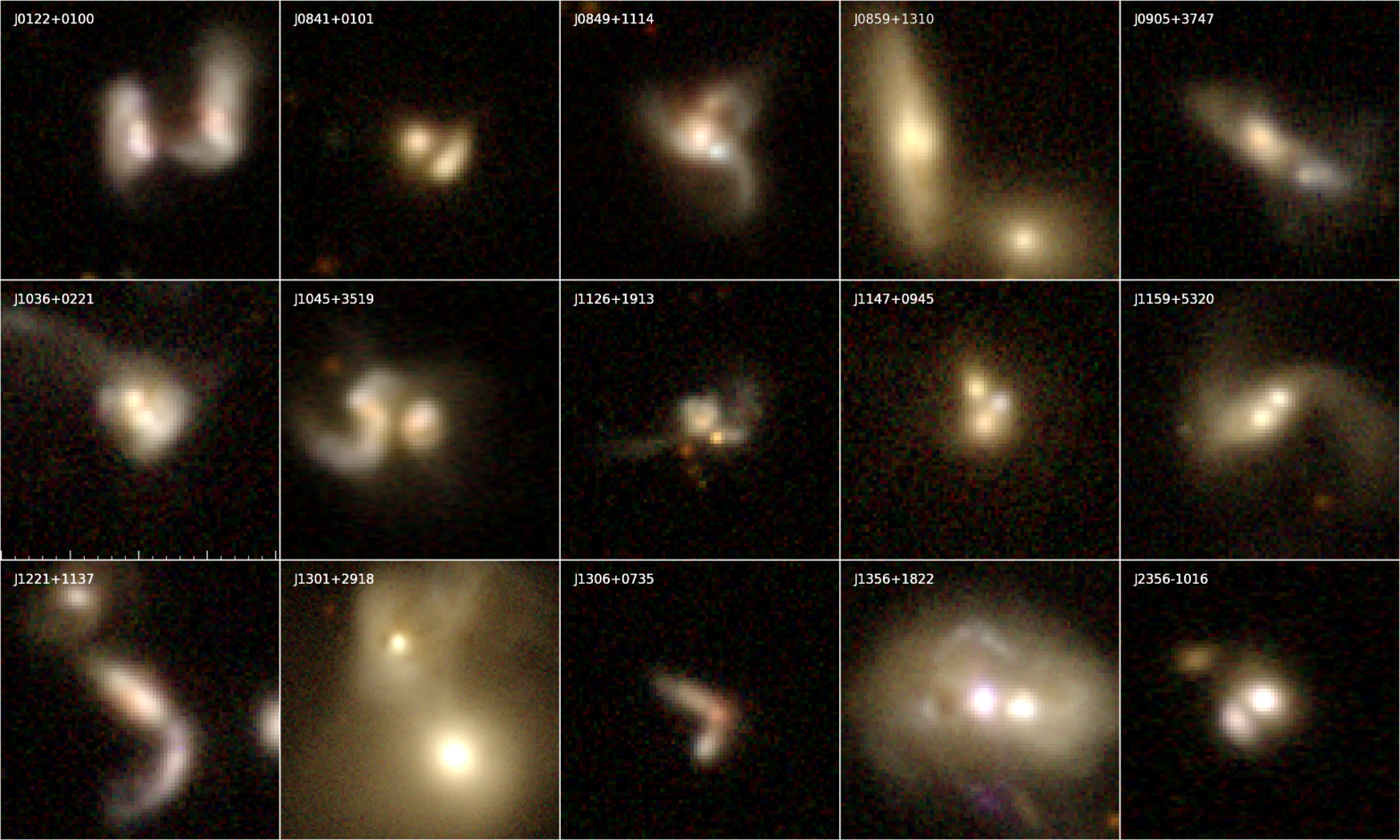27 June 2019
Astronomers discover eight buried dual AGN candidates
Astronomers discovered eight buried dual AGN candidates, the largest sample of hidden accreting supermassive black holes in late stage galaxy mergers, selected using NASA’s Wide-Field Infrared Survey Explorer (WISE) space telescope. This result will be presented by graduate student Ryan Pfeifle of George Mason University (Fairfax, Virginia, USA) at the annual meeting of the European Astronomical Society (EWASS2019)in Lyon, France, on Friday, 28 June.

Observational campaigns and theoretical studies have shown both that supermassive black holes (SMBHs) reside at the centers of most galaxies and that galaxy interactions are ubiquitous in the Universe. As a result, galaxies grow and evolve hierarchically through collisions, which also fuel and consequently grow the SMBHs at their centers.
Late-stage mergers should in fact host dual accreting SMBHs, or active galactic nuclei (AGN) – unambiguous evidence for an ongoing merger – with pair separations smaller than 10 kpc and are predicted to facilitate the most rapid growth of the black holes. Decades of observational campaigns have demonstrated, however, the exceeding rarity of dual accreting SMBHs.
Not only do the existence, frequency, and accretion rates of such dual AGN systems have important astrophysical implications on the formation and growth of SMBHs and their connection to the host galaxies in which they reside, they are the precursors of SMBH mergers, which will be the most titanic gravitational wave events in the Universe – a topic that is of current interest.

In a follow-up study the international team of scientists also reports – using high-spatial resolution X-ray, near-IR, and optical spectroscopic diagnostics – a case of a triplet of accreting supermassive black holes with mutual separations < 10 kiloparsec (= 33,000 light-years) in the advanced merger SDSS J084905.51+111447.2.
The dynamics of a triple massive black hole system can greatly shorten the merger timescale for two black holes.
Ryan Pfeifle explains: “The discovery suggests that this may be an important mechanism for driving the binary black hole inspiral and producing sources of gravitational waves.”

In addition, triple interactions can result in slingshot ejections of one of the black holes with velocities high enough to escape the host resulting in either ejected or wandering supermassive black holes.
Pfeifle concludes: “The results of our study demonstrates the true power of mid-infrared selection: it can select cases of dual AGN candidates that would be missed by optical selection techniques, and it now offers a method through which we can preselect triple mergers to try and find more triple AGN.”
This work utilized data products from the Wide-Field Infrared Survey Explorer (WISE), the Sloan Digital Sky Survey (SDSS), the Chandra X-ray Observatory (CXO), the Large Binocular Telescope Observatory (LBTO), the X-ray Multi-Mirror Mission (XMM-Newton), the Nuclear Spectroscopic Telescope Array (NuSTAR), and the Hubble SpaceTelescope (HST).
—————————————————————————————————
Science contact:Ryan W. Pfeifle, Ph.D student at the Department of Physics and Astronomy of George Mason University in Fairfax, Virginia, USA
E-mail: rpfeifle@masonlive.gmu.edu
EAS Press contact:
Marieke Baan
E-mail: ewass-press@kuoni-congress.info
Mobile: +31614322627
Image captions:
Triple AGN:
Morphology and X-ray properties of SDSS J0849+1114. This figure shows the archival HST WFC3 F105W image in the main figure and the Chandra 0.3-8 keV X-ray image in the top right corner, with HST contours overlaid on each. We also show in the bottom left corner the lower resolution SDSS tricolor image showing clearly the three separate nuclei in this late stage merger. The HST and SDSS images demonstrate the highly disturbed morphology of this advanced merger, while the Chandra image reveals three nuclear X-ray point sources with pair separations < 10 kpc. Credit: Pfeifle et al., ApJL, submitted.
SDSS images:
Morphological properties of the galaxy merger sample. This figure displays the SDSS tricolor images for the full sample of 15 late stage galaxy mergers. North is up and East is to the left. Each system exhibits highly disturbed morphologies and pair separations of 10 kpc or less, indicating these are late stage galaxy mergers. Eight mergers in this sample show no clear signs of AGN activity based upon the SDSS spectra, but rather manifest as star-forming or composite regions. Credit: Pfeifle et al., ApJ, Volume 875, Issue 2, i.d. 117, 2019.
X-ray images:
X-ray properties of the galaxy merger sample. This figure displays the Chandra X-ray 0.3-8 keV images with SDSS r-band contours overlaid on each panel for the full sample of 15 late stage galaxy mergers. North is up and East is to the left. In eight out of 15 mergers we find evidence for at least two nuclear X-ray sources, highly suggestive of dual AGN, and we find two of these systems exhibit three X-ray sources. In each merging system we also find at least one X-ray source and, in combination with our LBT spectroscopic results, we confirm each system hosts at least one AGN. Four of the dual AGN candidates show no signs of AGN activity in the optical. 14 out of 15 mergers show evidence for high absorbing columns along the line of sight, indicating these X-ray sources are heavily buried. Credit: Pfeifle et al., ApJ, Volume 875, Issue 2, i.d. 117, 2019.
Links:
@ryanpfeifle
GMU College of Science Twitter: @GMU_COS
GMU College of Science Website: cos.gmu.edu
At the annual meeting of the European Astronomical Society (EWASS2019) over 1200
astronomers are gathered 24-28 June in Lyon, France.
More information about the EAS annual meeting: https://eas.unige.ch/EWASS2019/More information about the EAS: http://eas.unige.ch
